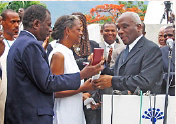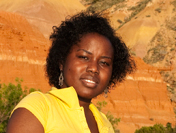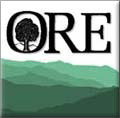ORE is a non-profit NGO, established in Haiti in 1985, and in Florida in 1986, to improve environmental, agricultural and economic conditions in rural Haiti by promoting high revenue tree crops, improved seeds, and marketing programs.
ORE a pour but principal l'amélioration des conditions écologiques, agricole et économiques liées aux milieux ruraux d'Haïti. Dans le sillage du tremblement de terre de 2010, une vraie catastrophe nationale, ORE se concentre sur les moyens de stabiliser la population et sur les possibilités d'offrir toute assistance disponible pour réduire la souffrance du peuple Haïtien. Nos projets de développements incluent la culture d'arbres a revenus élevés, la culture et la distribution de semences enrichies, la production de cultures de rente et la création de programmes de marketing – visant a l'augmentation des rendements et des revenus, a la production d'aliments riches au niveau de la nutrition, et visant a la protection de l'environnement. Parmi les efforts de rétablissements actuels, ces programmes joueront un rôle important dans le redressement à long terme du pays.
About ORE
ORE was initially established as Haitian NGO in 1985 and a year later a a 501(c)(3) Nonprofit Organization was set up as in Florida. As a local organization operating for over 25 years in Haiti, we have been able to gauge the needs of local population and adapt solutions to their way of life. The open letter below describes some of the success stories, as well as a look at our organizational structure and track record.
Dear Friends,
What would you say if they told you that something good was happening in Haiti? Isn’t Haiti the poorest nation in the west? Didn't the earthquake in 2010 totally destroy the capital? A country so deforested that floods periodically drown thousands of people – where for decades phrases like ‘desertification, soil erosion, abject poverty, malnutrition and illiteracy’ have been used with such abandon that we have grown tired of hearing the same old story and have all but switched off – thinking here is just another hopeless case, best forgotten.
But if you saw miles and miles of mountain roads lined with trees bearing fruits ready for market, farmers cheerfully harvesting and packing mango, avocados and citrus for local and export markets, would you say this was another country? Surely this can’t be right. Not in Haiti! Why, despite so much poverty and adversity, are these people still smiling? Perhaps because someone gave them hope?
“What, are you telling me? That something actually works in Haiti?” the lady at the World Bank asked me incredulously a few months ago. “Yes!” In the south of Haiti there are areas where farmers, who once were so poor they worked on Food for Work programs, are now growing and selling their own produce, earning enough money to cover their household expenses and more. On top of it, the trees that provide this income are protecting and restoring the environment.
So what is this success story all about? When Susannah Nesmith of the Miami Herald came down to Haiti some years ago it was to write an article about the disastrous failure of the efforts to reforest Haiti. A hard-nosed, but honest and perceptive journalistic, she visited the area where we work and after carefully investigation wrote that our efforts are ‘one of the few reforestation successes in Haiti.’
How does it work? In simple terms, only 1 or 2% of Haiti original tree cover remains – with all the disastrous effects on the environment you would expect. The farmers cut down trees because they need money. The solution is simple: to give the farmers trees that make more money every year than their value as wood. Perhaps hundreds of millions of dollars have been spent on reforestation in Haiti, without bearing this simple fact in mind – hence the widespread failure of so many programs. But when a few millions were used to fund our program of commercial tree crops, the result were high incomes by local standards and a return to a healthy, stabilized environment.

Around 1984, a friend, Felix Löwenstein, went high into the mountains of the recently established Macaya National Park, to see for himself why there was less and less water in the irrigation systems… he discovered that the rain-forest was rapidly disappearing, ancestral pine trees being cut down for planks and the surrounding mountains denuded. The community’s wealth would soon disappear. Something had to be done quickly. What kind of tree would the farmers value and protect on their land? Every type of forestry tree was cut down for energy or planks and posts; even fruit trees of poor fruit quality were destroyed for charcoal production. There was only one possible solution: commercial fruit production, whose potential to generate renewable income would surpass the wood value of the trees. This prompted my parents to start a small grass-roots organization designed to help the community on a permanent basis. We introduced grafting, collected and propagated all the best quality commercial fruit, researched markets and propagated over a million trees. After two decades, the landscape in the area where we live has changed for the better and tens of thousands of farmers have come to prosper. We want to maintain this spark of success and hope alive with your help.
Too good to be true? The figures show that the annual income from the trees planted is equal to the total amount invested. In other words, every dollar of funding has created farm-gate income of a dollar every year from the sale of fruits – and these trees produce for 30-40 years! The trees and the farmers prospering from their fruits are there. You can fly to the south of Haiti and see them for yourself.

Today there is a need to increase awareness that there is very effective, practical way to help the Haitian people. We need to show that there is a proven example of how whole areas of the country have been ‘saved’ from desertification and the poverty and despair of subsistence farming. How these areas have been given hope through commercial agriculture and now the families receive a decent return from their labor. Every dollar donated means a dollar a year of income for the farmers – and hope for the future in a terms ecological stability.
Why is it worth helping? Despite a succession of coups, an embargo, civil wars and political turmoil, and a world-shakinglingly devastating earthquake, Haitians have maintained their position as one of the largest exporters of mangos in the Caribbean, and the farmers participating in our program have grown from small groups to a federation of producer groups. Even in the darkest of times it is possible to achieve good results. We need to expand the success in the south of Haiti to vast regions of severely deforested mountains elsewhere in the country.
Rather than just providing disaster relief, rather than aid and feeding programs, we want to expand the country’s production capacity, and create sustainable wealth from trade.
One of ORE's key programs is the production of bio-fortified foods. The improved seed program which was started in the late 80s has been focusing on quality protein maize, with the same nutritional value as milk, and on vitamin and mineral enriched staple crops. Biofortification is the process of breeding staple food crops that are rich in bio-available nutrients. Through plant breeding, crops fortify themselves and load nutrients into their seeds and roots, which are then harvested and eaten. Through biofortification, it is possible to provide farmers with crop varieties that naturally reduce anemia, cognitive impairment, and other nutritionally related health problems, and potentially reach millions of people.
What can you do to help? We need to give the program exposure so that that the individuals and organizations who would like to help resolve Haiti’s problems can make a clear, well-informed choice about the options. We need to generate on-going public awareness – so that the folks who really want to help can easily do so. There are so many people who would like to help reduce the suffering in the world. If they knew that that they can easily give real lasting help, if they know that here is something that really works, and that the blessings would last for decades, they would doubtless do so. We need the help of those in the public eye to give out the message, to get support for the program.
If you hear the farmers’ appeal for help you cannot help being moved. When my car broke down recently in a remote mountain area, the farmers took me for a walk and showed me a special variety of avocado trees we had distributed many years earlier. They described the numbers of fruits each tree produced and proudly told me for how much they were able to sell it. In a country where the annual income is still $1 a day, no wonder they are amazed that they can earn that much by selling 2 or 3 high quality fruits, and that their trees bear hundreds of fruit annually, year after year. Before I left, they begged me to find a way to get them more trees. They are not asking for a endless handouts, they are asking for a means to solve their own problems. The look in their eyes still haunts me, knowing what they are going through, and knowing that it is possible to help them…
Warm regards, God bless,
Nimi Finnigan,
President, ORE-USA.
ORE Haiti is a Haitian Non-Government Organization established in Haiti as the Organization for the Rehabilitation of the Environment, L'Organisation pour la Rehabilitation de l'Environnement. ORE's headquarters are located in Camp Perrin in the south of Haiti.
A year later a non-profit organization was also set up in Florida, ORE-USA. The two organizations have similar aims: to improve environmental, agricultural and economic conditions in rural Haiti.
ORE Haiti has implemented numerous programs funded by USAID, the European Union, IADB and UNEP making a significant impact on the economic and environmental conditions in the south of Haiti. Its mission is to improve environmental, agricultural and economic conditions in rural Haiti by promoting high revenue tree crops, improved seeds, and marketing programs. As a local organization, we have been able to gauge the needs of local farmers and adapt solutions to their way of life. Read more about ORE's programs >>

Dr. Mousson Pierre Finnigan, CEO of ORE Haiti, was among 15 women selected
for the national first award of 'Femmes de Mérite' en 2009.
ORE-USA: In 1986, The Organization for the Rehabilitation of the Environment Inc was established as a Florida Non-Profit Corporation with (501(c)(3) tax-exempt status): ORE Inc. P.O. Box 326, Boca Raton, FL 33429-0326, USA.
The US based non-profit organization, has maintained a collaborative role, seeking funding support for program activities in Haiti, but does not directly execute overseas activities. The program activities are implemented by ORE-Haiti.
ORE-USA has been very active in providing support for the humanitarian relief program for earthquake survivors. As a local NGO we have been able, thanks to your support, to rapidly respond within Haiti with local assistance where it is most needed. For more information about how to help the program please click here: www.oreworld.org/donate.htm
Read more about ORE's programs >>

Nimi Finnigan, President of ORE-USA, who grew up in Camp Perrin, Haiti,
is devoting her time to promoting support for Haiti.
Support our efforts to give farmers more high value trees



